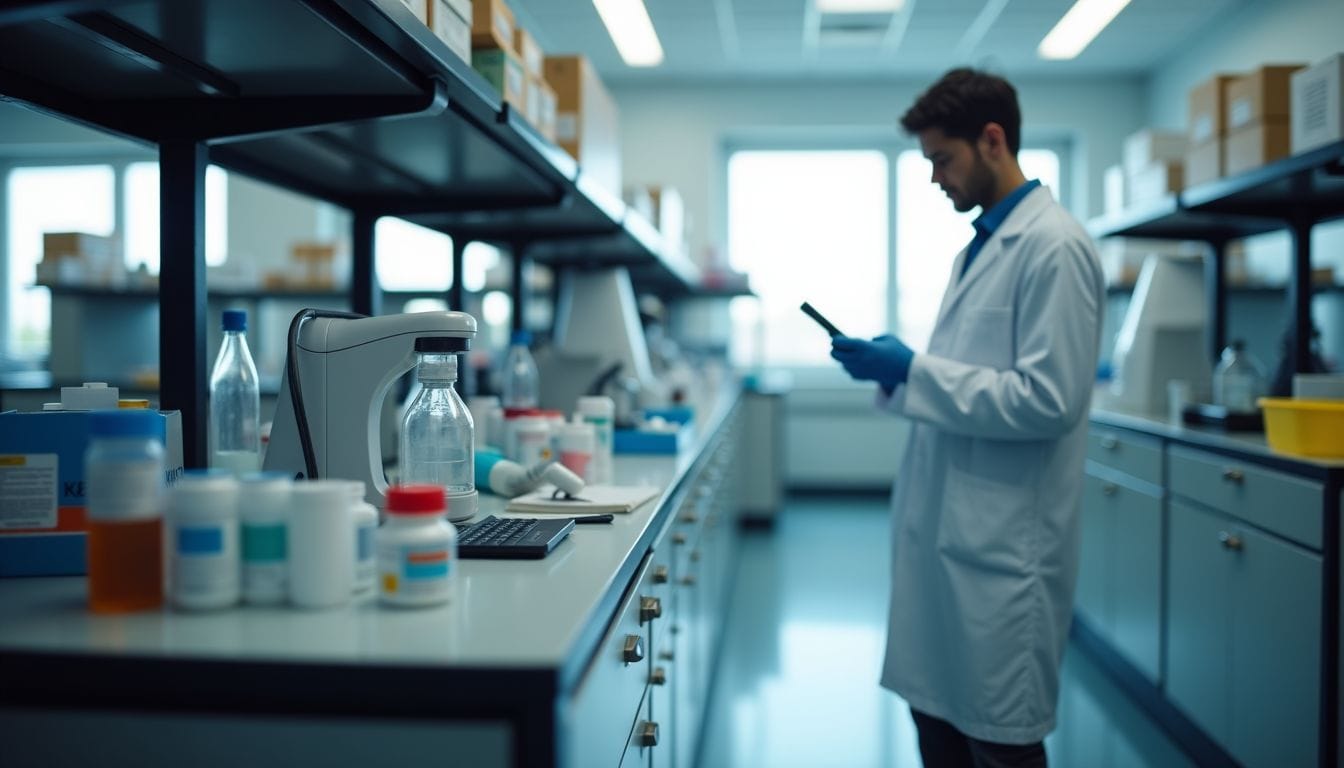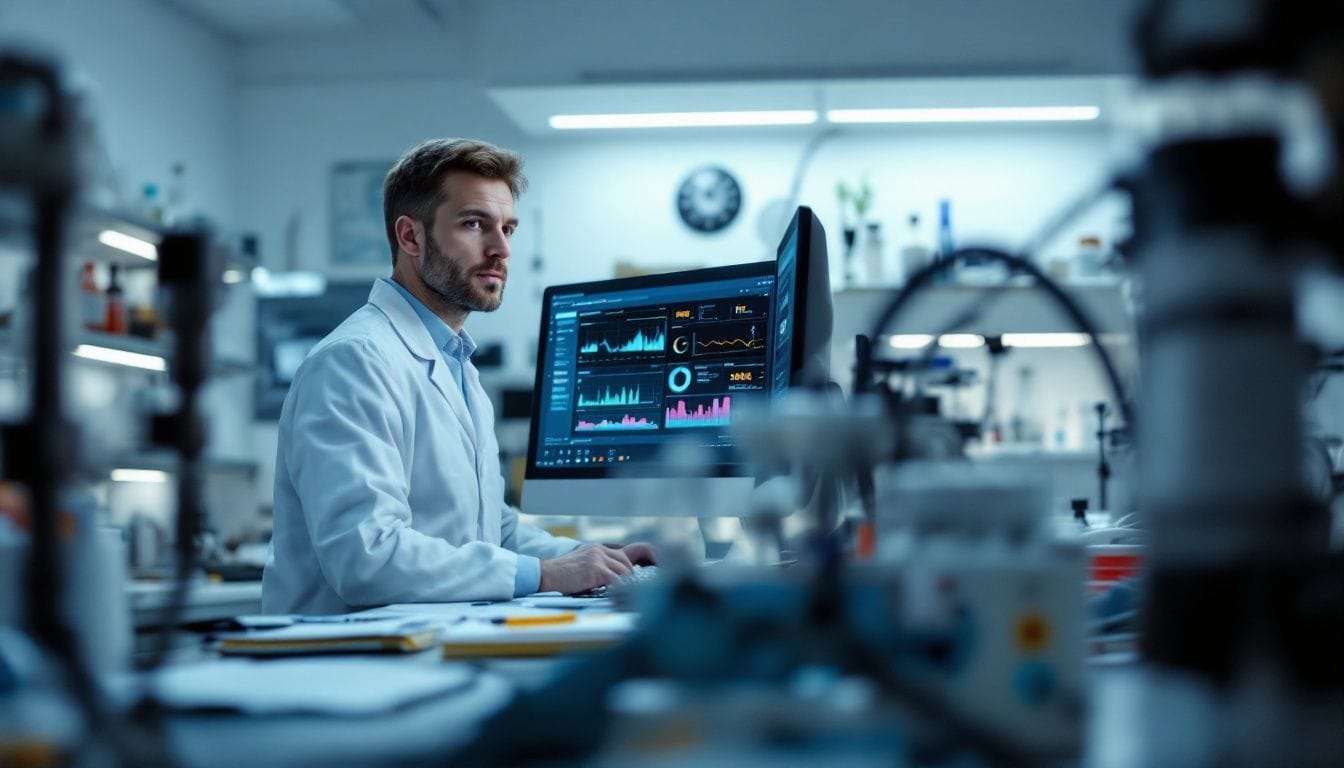Maximising R&D Tax Credits in Medical & Pharma Industries
Struggling to maximise r&d tax credits for medical and pharma industries? You’re not alone. Many companies miss out on substantial benefits due to complex rules and changing policies.
Did you know? The average cash saving on development projects is 25%. This guide will show you how to boost your claims and avoid common pitfalls. You’ll learn to identify eligible activities, document properly, and navigate the application process.
RD Tax Credits UK can help you secure more funds for your innovative work. Ready to unlock your full R&D potential?

What Are R&D Tax Credits?
R&D tax credits are cash incentives from the UK government. They reward companies for innovation in science and tech. You can claim up to 33.4% of your R&D costs back. This applies to both profitable and loss-making firms.
The credits aim to boost growth in key sectors like health and pharma.
These credits cover a wide range of activities. They include creating new products, processes, or services. You can also claim for improving existing ones. The average benefit for health and pharma clients is £313,000.
From April 2023, the RDEC rate rose to 20%. This means even more savings for innovative companies.

How Do R&D Tax Credits Apply To The Medical Industry?
R&D tax credits give a big boost to medical firms. They help cover costs for new drugs, devices, and treatments.
Eligible Medical Research Activities
Medical research can qualify for R&D tax credits. You might be eligible if you’re working on these projects:
- Making new medicines or improving current ones.
- Creating tools to diagnose, treat, or check health.
- Testing new drugs or treatments on people.
- Using living things to make products or fix problems.
- Finding new ways to spot illnesses or health issues.
- Making jabs to stop catching diseases.
- Changing genes to treat or prevent illnesses.
- Making better ways to see inside the body.
- Making fake body parts or improving current ones.
- Making computer programs to manage patient info or help diagnose.
These are just some examples. If you’re doing any of these, you might be able to claim R&D tax credits.
Qualifying Expenditures In Medical R&D
R&D tax credits can cut your medical research costs. You can claim for many costs in your projects.
- Staff costs: Your team’s wages, pay, and bonuses count. This includes pension and NI costs too.
- Used-up items: Things used up in your R&D work count. Think lab goods or test part bits.
- Trial fees: Money paid to test people or hospitals is valid.
- Data fees: If you buy data for your work, you can claim it.
- Cloud costs: Using cloud for your R&D? You can claim these costs.
- Outside workers: People hired for your R&D projects also count.
- Software: Programs used just for R&D are okay to claim.
- Power and water: Some of your bills may count if used for R&D.
- Work sent out: Tasks given to others for your R&D can be claimed.
- Travel costs: Trips for your R&D work are often missed but valid.

What Benefits Do R&D Tax Credits Offer To Pharmaceutical Companies?
R&D tax credits can slash costs for drug makers. They also spark new ideas in pharma, pushing the field forward.
Cost Reduction In Drug Development
R&D tax credits can cut drug making costs by up to 33.4% for firms losing money. This helps drug firms buy new tech and run tests. You’ll save big on staff pay, software, and research items.
These credits lower tax bills for R&D spend that fits the rules. It’s a big help for small and large drug firms. You can get cash back for work on new drugs, ways to give drugs, and medical tools.
This extra money helps UK drug firms make more new things.
Smart firms use these credits to pay for risky work. They can try new science without spending too much. With good planning, you’ll get the most from your claims and spend less. This helps your money and helps make new medical finds.
Incentives For Innovation In Pharma
Pharma firms get big rewards for fresh ideas. Tax breaks for research cut costs and boost profits. In the UK health field, you can claim up to £313,000 on average.
These credits help firms try risky projects. They cover lab work, trials, and tech upgrades. You can use the saved money to hire more staff or buy new gear. This keeps your firm ahead in a tough market.
The UK wants more pharma breakthroughs. That’s why they offer these tax breaks. You can claim for work on new drugs, devices, or methods. Even failed projects count. This support helps UK pharma stay top-notch.

Which Medical And Pharma Activities Typically Qualify For R&D Credits?
Medical and pharma firms can claim R&D credits for many activities. These range from drug trials to new device creation.
Clinical Trials And Testing
Medical trials are vital in health research. They check new drugs and care on people. These tests show if a drug works and is safe. Costs for trials can be very high. But you can claim tax credits on many costs.
This includes staff pay, lab goods, and outside research work. Be sure to track all your spending well.
Testing is key in drug research too. It helps solve science issues in making drugs. You might make new ways to test drugs. Or you could make old ways better. Both count as research work.
Keep good notes of all your tests. This will help you claim more tax credits. Even failed tests can count for research relief.
Drug Formulation And Delivery Systems
Drug making and delivery systems are key for R&D tax credits in pharma firms. You can claim for work on new drug forms, like pills or shots. This includes efforts to make drugs more stable, work better, or be easier to take.
Delivery systems are vital too. These help get drugs to the right spot in the body. You might work on patches, inhalers, or slow-release pills. All these can qualify for R&D tax relief.
The aim is often to boost how well the drug works or cut side effects.
R&D in this field tries to solve hard science problems. You might try to make a drug that lasts longer in the body. Or you could work on getting a drug past the blood-brain barrier.
These complex tasks often fit HMRC’s rules for R&D tax credits. Keep good notes of your work to back up your claim.
Medical Device Development
Medical kit makers can get tax money back for their work. They can claim for testing new gear and making better ways to build it. This includes work on computer programs for medical tools.
Many firms don’t know they can get cash for this work.
Tax relief helps cut costs when making new medical kit. On average, firms get £313,000 back for device projects. This money can help pay for more studies or new tools. It’s a big help for both small and large medical firms in the UK.
To get these tax credits, you need to keep good notes. Write down all your tests and trials. Show how you fixed tech snags. This proof helps you claim more money back. With the right help, you can make sure you get all the credits you should.

How Can Medical And Pharma Companies Maximise Their R&D Tax Credits?
Medical and pharma firms can boost their R&D tax credits through smart planning. Want to learn how? Read on for tips to get the most from your claims.
Proper Documentation Practices
Good records are key for R&D tax claims. You must track all your research costs and work. Save project plans, lab notes, test results, and money records. Good papers help you claim more and avoid errors.
Clear records show what you spent on R&D. They prove your work counts as research. With solid proof, you can claim more tax relief. It’s wise to link your R&D work to your tax plans.
This helps you get the most from the scheme.
Identifying All Eligible Projects
Find all projects that can get you R&D tax credits. A full review can help you claim more money.
- Look in all parts of your company for R&D work
- Check your software projects
- Look at new medical device work
- Review chemical studies
- Check drug changes
- Include testing of new models
- Think about ongoing medical tests
- Look at ways to make things better
- Review tests that didn’t work
- Include work to fix hard problems
- Look at new ways to make things
- Check work to make products better
- Think about projects that didn’t sell
- Look at work with schools or labs
- Review new ways to spot illness
- Check work to help the earth
- Look at new ways to give drugs
- Think about new tools for doctors
- Review work on new body-safe materials
- Look at ways to make things cheaper

What Are The Recent Changes In R&D Tax Credit Policies Affecting These Industries?
Recent changes in R&D tax policies have shaken up the medical and pharma world. Want to know how these updates affect your business? Read on!
Updates In Tax Laws
Tax rules for research and development credits have changed a lot. From 1st April 2023, the tax rate for companies rose to 25% from 19%. The rate for research and development also went up to 20% from 13%.
Starting 1st April 2024, there will be one 20% credit rate for all costs that qualify. These changes affect how drug and medical firms claim tax relief for research.
You now need to send claims online with lots of details. This new rule helps the tax office handle claims faster. It also means you must keep good records of your research work. Make sure you track all costs tied to your medical studies or drug work.
This will help you get the most from the new tax credit scheme for research and development.
Industry Specific Modifications
The UK government has changed R&D tax rules for medical and drug firms. From April 2024, you must do R&D work in the UK to claim costs. This change aims to boost local ideas. The SME tax relief rate has also changed.
Since 1 April 2023, it’s now an 86% boost on costs. These updates affect how you plan and budget for R&D projects.
New limits on overseas R&D spending are coming too. You can’t claim for some subcontractor and EPW costs from abroad after April 2024. But there are some exceptions. These changes push UK-based research.
They also affect how you set up your R&D teams and partners.

How Do R&D Tax Credits Impact Small Vs. Large Medical And Pharma Companies?
R&D tax credits affect small and big medical firms differently. Want to know more? Keep reading!
Startup Benefits
Medical and drug startups can get big rewards from R&D tax credits. These credits give back up to 33% of money spent on research. This extra cash helps new firms grow faster and try riskier projects.
You can claim for work done up to two years ago. This gives you time to sort out your books.
Small firms often have more room to try new things. This makes them just right for R&D tax credits. You can claim for many tasks, like making new drugs or better ways to make them.
Even if your tests fail, you can still claim. This helps pay for the high costs of medical research.
The UK wants to help new firms grow. That’s why they made these tax credits. As a startup, you can get more money back than big firms. This makes things fair and helps you keep up.
Just check you’re not getting other state help, as this can change your claim.
Considerations For Established Corporations
Big firms face special issues with R&D tax credits. They can get a 16% tax cut on R&D work that fits the rules. This perk helps profits and drives new ideas. But large firms must be very careful.
They need to split their own projects from ones with grants. Tax checks have gone up, so good reviews are key. Keeping proper records is vital to back up claims.
Old firms should look at all work that fits the rules. This includes making new products, updating tech, and fixing how things work. Don’t miss out on office staff costs that help R&D.
Smart firms get expert help to find all ways to claim. This makes sure they get the most from the tax break.

What Common Mistakes Should Medical And Pharma Companies Avoid When Claiming R&D Credits?
Medical and pharma firms often miss out on R&D credits due to simple errors. Want to learn how to avoid these costly mistakes? Read on….
Overlooking Eligible Activities
Many drug firms miss out on research tax credits. They often fail to spot all their eligible work. You might be doing research without knowing it. Things like changing drug recipes or testing new tools count too.
Don’t forget about staff costs, materials, and computer programs. These are all part of research spending. Even money paid to clinical trial helpers can be claimed. It’s vital to keep good records of all your research costs.
Small changes in your lab or factory could be research. Making drugs or medical gear better often counts. Don’t miss these chances to claim back money. Every bit of new thinking can help cut your tax bill.
Insufficient Record Keeping
Bad record keeping can ruin your R&D tax credit claim. You need clear proof of your work for HMRC. You must track all costs and time spent on R&D projects. This means keeping good logs, receipts, and notes.
Poor records often lead to turned down claims. You can’t use NDAs or trade secrets as an excuse. HMRC wants to see the nuts and bolts of your R&D work. They’re getting stricter about this, too.
Your papers need to be spot-on and full.
To up your chances, start good habits now. Log all things tied to your R&D work. Keep all bills and time sheets. Write down project goals and progress. These steps will help you claim what you’re owed.
Plus, they’ll make the whole process easier.

How Can Medical And Pharma Companies Navigate The R&D Tax Credit Application Process?
Get expert help to breeze through the R&D tax credit process. Read on for more tips….
Step by Step Application Guide
Claiming R&D tax credits is easy. Follow these steps to get the most from your claim:
- Find R&D work that fits
- Look for projects that push science or tech forward
- Focus on work that tackles tricky problems
- Get project info
- List all R&D tasks and their costs
- Include staff time, goods, and outside help fees
- Check if your firm can claim
- Make sure you have less than 500 workers
- Look at your money figures against set limits
- Keep good records
- Save clear notes of all R&D work
- Keep emails, meeting notes, and test results
- Add up your R&D spend
- Total all costs linked to R&D
- Use HMRC rules to get it right
- Fill in the CT600 form
- Put your R&D claim details in
- Send it with your Company Tax Return
- Write a tech report
- Tell about your R&D projects in full
- Show how they meet HMRC rules
- Send in your claim
- Post all papers to HMRC
- Do this within two years of your tax year end
- Answer HMRC questions
- Reply to any queries fast
- Give more info if they ask
- Get ready for new rules
- Prepare for changes from 1 April 2024
- Update how you work to fit the new joined-up scheme
Working With Tax Professionals
Tax experts can be your best mates when claiming R&D credits. They know all about the rules and can spot work you might miss. These pros help you track costs and keep good records.
This is key to getting your claim approved.
Working with a tax expert makes it more likely you’ll get R&D credits. They guide you through the tricky process and make sure you do it right. They also stay up to date on new tax laws.
This means you won’t miss out on new perks.
A good tax pro saves you time and stress. They do the paperwork while you run your business. With their help, you can get the most R&D tax relief. You can then use this money to grow your company.
Conclusion
R&D tax credits boost medical and pharma innovation. You can claim for clinical trials, drug formulation, and device development. Proper documentation and expert guidance maximize your benefits.
RD Tax Credits UK helps you navigate recent policy changes. Don’t miss out on this chance to fund your next breakthrough.

